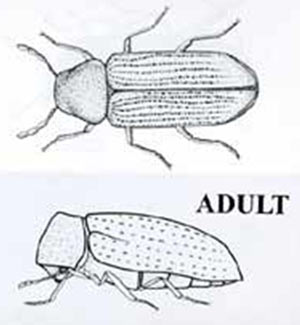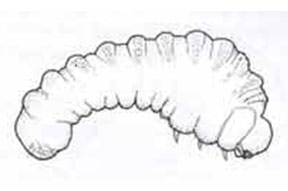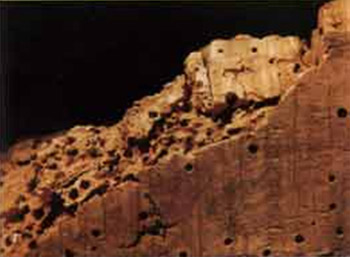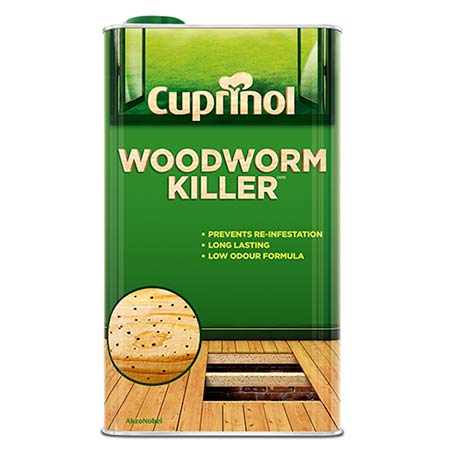Most woodworm infestations can be treated with DIY skills and tools quite easily and effectively. In the guide below learn how to treat woodworm and get rid of wood boring insects in your home for good.
Woodworm Treatment Advice and Woodworm Diagnosis
There are three types of woodworm beetle in the UK and we have pictured them below for easy identification and to help you diagnose the different types of infestation if you think you have woodworm evidence in your home. Pictured also is the damage each one causes to the timber, because it does differ for each different type of woodworm.
The Common Furniture Beetle which is what we normally refer to as woodworm.

Common Furniture Beetle larva

Common adult Furniture Beetle AKA Woodworm

Damaged caused to timber by common furniture beetle
The House Longhorn Beetle is rarer but much more destructive, more on this later in the project.

Longhorn Beetle larva

Adult Longhorn Beetle

Damaged caused by Longhorn beetle
Last but not least the Death-Watch Beetle, which is the one that sounds the worst! We explain the process for treating this destructive beetle at the end of the project.

Deathwatch beetle larva

Adult Deathwatch beetle

Damaged caused by Deathwatch beetle
The first thing you will notice is that they are all beetles and not worms at all. I think most people realise that the worm bit in woodworm refers to the larvae state when the beetle is a grub that looks more like a maggot, so is known as a wood ‘worm’.
How to Detect Active Woodworm
There is a common misconception that woodworm is inactive once the holes appear in the wood. While it means that that particular ‘worm’ has grown up and left the nest as a beetle it does not mean there are not more in the wood and in fact that same beetle may be back to lay its eggs starting the whole woodworm lifecycle off again.
So, how do you tell if the woodworm is active or not? If the woodworm is still active there will be signs of droppings or frass, which looks like fine sawdust, around the affected area.
I remember carrying out work for a letting agent in Somerset where a tenant was so concerned about the woodworm that was in the furniture that she lay in wait for confirmation of the beetles emerging so she could confront the landlord with it.
Indeed she captured her evidence and brought it into the Letting Agent’s office in a jar, at which point the landlord had to agree to treat the woodworm!
If the wood was good for woodworm once it will be a good feeding ground again if it remains untreated. As woodworm and damp often go together an attack is a good indicator that your timber is not in good condition.
Common Furniture Beetle or Woodworm

The lifecycle of the Common Furniture Beetle or Woodworm
Woodworm in Furniture and Other Timber
If you see very small holes scattered across the surface of timber or furniture, you have evidence of woodworm. There are usually a cluster of holes and each hole is around 1-2mm wide.
As mentioned at the beginning, these holes are where the adult beetle has emerged from the wood after spending the primary part of their lifecycle as a larva within the wood. They are therefore known as emergence holes or exit holes.
While woodworm is in the larval state they tunnel their way through the wood. The damage they do is mainly cosmetic unless there is also damp in the wood, or the timber is very slender. Obviously it is still better to treat the wood, but it is not usually cause for alarm if you find evidence of this common furniture beetle.
As the name suggests they are the most common species of woodworm. They attack softwood timber like pine but they are very at home in plywood and may stay within it for prolonged periods of time especially if the conditions are slightly damp.
Woodworm and Damp
While conditions do not need to be damp for woodworm to survive they will certainly thrive where the timber is moist. Therefore damp floorboards or loft timbers are prime real estate for woodworm, but of course they will also make a home in our furniture, and because this is under our noses we are more likely to spot woodworm damage in furniture.
Beetles are most likely to choose untreated wood to lay their eggs so you are most likely to find woodworm in furniture where the polish or finish has worn off, and where it is kept in damp conditions.
However the woodworm will live in other conditions, so don’t discount it just because the conditions are not ideal for it.
If you have woodworm in furniture but you have other timber in the house that makes a better home for the beetles to lay their eggs they will find it! So it is much better to treat when you see evidence of woodworm.
Woodworm Treatment – How to get rid of the Common Furniture Beetle Woodworm
We would recommend that for DIY purposes the best woodworm killer to use is a good quality off-the-shelf product available from your local DIY store such as Cuprinol Woodworm Killer or a similar quality product.
Most products such as this today are water-based and contain lower amounts of VOC’s (volatile organic compounds). However, as they do contain traces of VOC’s you should wear full PPE (gloves, goggles, masks etc.) when using them and ensure children and pets are kept well away form the treatment area.
When choosing suitable treatments, also look for those that have good penetration levels, protects against a wide range of pests and also prevents any re-infestation for as long as possible.
In terms of applying always refer to the manufacturers directions but in most cases it can be brushed on using a paint brush. Normally 2 – 3 coats should be applied for full protection and also ensure any end grain and any surrounding timbers are fully coated also.

Cuprinol woodworm killer
As with all jobs, if you don’t fancy tackling the it yourself there will almost certainly be a local professional that can do it for you.
However, many contractors and professionals use a chemical called Permethrin but this has unpleasant vapours and smells and it is also hazardous to other insects and even mammals, which is a consideration if you have bats in your belfry.
Bats are a protected species and it would be illegal to carry out work or treatments that would cause harm or disturbance to roosting bats, so bear this in mind if you are treating woodworm in your loft or attic.
Solving the Root of the Problem
Before any treatments are applied to any infected surfaces the root cause of any infestation problems must be fixed first.
In the majority of cases woodworm and other wood-boring insects are drawn in by damp and moist conditions that then penetrate timber and create ideal conditions for these pests.
Leaks can come in many forms, sometimes the least expected location can indeed be the culprit so it’s important to not rule out any potential cause.
Once you have tracked down the root of the issue ensure it’s repaired correctly to prevent the same problems occurring again.
Normal Treatment – Surface Treatment
Normal DIY treatments or surface treatments as they are known, with any of the off-the-shelf woodworm killers is fairly straightforward. In pretty much all cases first read the manufacturers instructions and then apply in respect to what’s stated.
This will normally be applying the product using a paint brush. Simply brush it on to the surface using a decent coating and allow it to soak in. Most decent quality products will penetrate quite deep into the timber.
With the first coat applied, leave for a few hours or so and then apply the second coat and the third if needed following the same pattern. Once all applied leave for at least 24 hours or so (refer to manufacturers guidelines) to dry and then you can safely apply further wood preservers, other treatments and paint or varnish.
Surface treatments such as these work well when treating infestation from Common Furniture beetles, but they are not so great for other pests such as Death Watch beetles as they tend to dig much deeper into timber.
As we have stated but will do again, ensure you treat any surrounding timber to prevent any infestation in these surfaces.
Heavy Infestations
For very heavy infestations of common furniture beetle, simple surface treatments may not quite be enough to kill any off fully.
Generally, heavy infestation is where there are many, many woodworm holes close together over quite a wide area and dust evidence in and around many of the holes indicating widespread active beetles.
In these instances it’s best to use a gel-based woodworm/insecticide treatment such as Lignum Pro Gel Insecticide or any other good quality gel-based insecticide.

Brushing on gel Woodworm treatment
Infestation and Damp
As we have discussed, damp is quite often the cause of many woodworm and wood-boring insect infestations as conditions such as these are ideal for nurturing such pests.
Where any timber gets damp, before any repairs are made it must be allowed to dry out, which first means fixing the issue that caused it to get damp in the first place.
Once this is done allow the timber to fully dry out and then treat it with a fungicidal/insecticidal wash to prevent any chance mould or fungal growth. This treatment must also be allowed to fully dry before any further treatments are undertaken.
Re-Entry Time After Treatment
In the majority of cases, most woodworm treatments use chemicals that can be harmful if breathed in or allowed to touch your skin, therefore gloves, goggles, old clothes, masks etc. should be worn at all times.
After a treatment has been applied, the manufacturer will state that the area should be evacuated for a set period of time to allow the product to penetrate in and allow any fumes to disperse.
The time that a space should be left is known as the re-entry time and this guideline is set by the Health and Safety Executive (HSE). Always check the manufacturers recommended re-entry time to know when it’s safe to access a treated area once more.
Caution
As mentioned previously most wood-boring insect treatments use chemicals, normally Permethrin or a similar VOC (volatile organic compound).
In respect to this Permethrin-based woodworm treatments can be harmful to pets and many other animals.
It is absolutely lethal to fish even in minute quantities. Permethrin is in most DIY treatments available in the DIY Sheds and high street stores, so be aware of this and keep any pets well away.
House Longhorn Beetle Woodworm
For those of you who do not live in Surrey you will be pleased to know that the House Longhorn Beetle (Hylotrupes Bajulus) is not very common in the UK.
If you do live in Surrey and you have woodworm you should be very careful to make sure you get correct diagnosis of your woodworm.
Where the House Longhorn Beetle is in evidence it prefers roof timbers and only attacks softwoods. Unlike the Common Furniture Beetle the larvae of this species causes holes and tunnels in the wood that are much bigger than the furniture beetle and infestation does cause severe structural damage to the timbers.
If you suspect infestation you should contact your local council and get professional advice as soon as possible. You can also notify the Building Research Establishment (BRE). The BRE monitor the spread of this destructive beetle and they produce reports on the spread of the beetle across the home counties.
Woodworm Treatment – How to get rid of House Longhorn Beetle Woodworm
Do not attempt to treat infestations of the house Longhorn Beetle as a DIY task. As it is so destructive it should only be handled by a professional who can advise on the structural damage caused as well as the treatment necessary.
For a qualified timber treatment company you can find your nearest PCA Member (Property Care Association) by visiting they’re website here.
Death Watch Beetle Woodworm
Death Watch Beetle sounds so terrible but in fact it is not a serious as a Longhorm Beetle infestation.
Death Watch Beetle is relatively common in Southern England, whereas the North of England and Scotland are largely unaffected.
It tends to infest hardwoods such as elm and oak. Imported timbers are more likely to be attacked, with French Oak being a particular delicacy for the beetles. However once it is over here it will also lay eggs in softwoods.
This woodworm prefers its timber to be damp and even wet. It is especially happy if there is also fungal decay (wet rot) in the timber too. Funny what sort of home some species like isn’t it?
So to truly thrive this beetle wants conditions that you would not want in your house in any event, so it is not a very common pest for that reason.
Unlike the Common Furniture Beetle this woodworm has a ten-year life cycle which does make treatment a bit more difficult.
The Death Watch Beetle is also much more destructive while it is feeding on the timber and can cause severe structural damage to timber including large structural timbers.
Woodworm Treatment – How to get rid of the Death Watch Beetle Woodworm
The feeding patterns of the Death Watch Larva will leave sections of the timber hollow so to find out which areas need treating tap or ‘Sound’ the timber with a hammer.
You will be able to hear the difference between solid timber and any hollow sections.
Test these hollow areas by drilling into the affected areas with an 8 – 10mm diameter auger, so you can establish the parameters of the infestation.
When you have worked out where you need to treat you can use a gel-based woodworm killer to treat the infestation.
Drill into Timber
For large timbers, drill 10mm diameter holes to within 15mm of the opposing face, using the drilling pattern similar to the one in the image below.
You can then use a gel or paste-based woodworm treatment to penetrate deep into the timber and kill the infestation where more surface-based treatments may fail.
Once the treatment has penetrated deep the holes, cap off the hole with a timber dowel and remove any excess paste with a cloth. Find out how to cut and insert timber dowels in our project here.

Example of a Drilling Guide for Treating Timber for Woodworm available from Property Repair Systems
Treat the Surface
Once any paste left on the surface is dry, brush on 2 – 3 coats of a good quality timber treatment or preserver on to the effected areas and also any surrounding timber surfaces, allowing each coat to dry before further application.
This will help to ensure that no wood-boring pests can re-infect the timbers at any point in the future.
Monitor Your Woodworm Treatment
Because the lifecycle of the Death Watch Beetle is so long, you should continue to check for infestation on an annual basis for at least ten years.
If you spot signs of activity you will need to re-apply any treatment where necessary using the above pointers.
Please note – Surface treatment alone is not sufficient to deal with Death Watch Beetle, you do need to get the treatment into the core of the timber.
If you do not want to tackle this task as a DIY project, you should get professional help and advice from a knowledgeable and reputable specialist.
Preventing Re-Infestation of all Woodworms
We advise that you carry out annual inspections for signs of woodworm activity, and treat again as necessary if you find any evidence of re-infestation.
We hope that you have found this project on woodworm treatment advice and diagnosis for the different types of woodworm beetle useful.
If you are still unsure about woodworm infestation or treatment and would like additional help then visit the Property Care Association website and find a professional local to you that can visit and advise you further.

